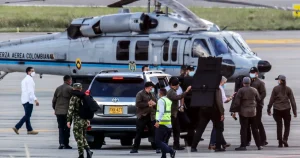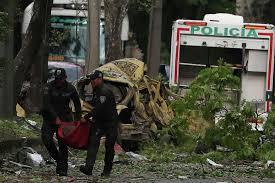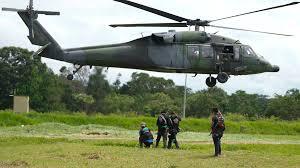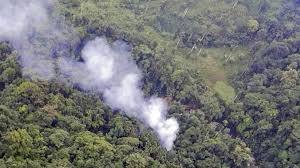Colombia, South America – A devastating Police Helicopter Attack In Colombia occurred on Thursday, resulting in the deaths of eight officers and injuries to eight others during an anti-drug operation in the northern region of Antioquia. The attack, which was captured on video and circulated widely on social media, represents one of the most brazen assaults on law enforcement personnel in recent Colombian history.
President Gustavo Petro confirmed the casualty figures following the Police Helicopter Attack In Colombia, initially reporting six deaths and seven injuries before updating the death toll to eight officers killed. The incident has shocked the nation and highlighted the ongoing security challenges facing Colombian authorities in their fight against illegal drug cultivation and trafficking.
FARC Dissidents Responsible for Fatal Assault


The Police Helicopter Attack In Colombia has been attributed to dissidents of the defunct Revolutionary Armed Forces of Colombia (FARC) by President Petro, who announced the attribution through social media. These FARC remnants continue operating in various regions despite the 2016 peace agreement that officially ended the group’s five-decade insurgency against the Colombian government.
The targeting of law enforcement in this Police Helicopter Attack In Colombia demonstrates the continued threat posed by these dissident groups, who have rejected the peace process and maintain involvement in illegal drug trafficking activities. Their use of drone technology marks a concerning escalation in their capabilities and willingness to directly engage government forces.
Anti-Drug Mission Targeted During Coca Eradication
According to President Petro, the Police Helicopter Attack In Colombia occurred while the aircraft was transporting police personnel to Antioquia for coca leaf crop eradication operations. These crops serve as the raw material for cocaine production, making their elimination a crucial component of Colombia’s anti-drug strategy and international cooperation efforts.
The Police Helicopter Attack In Colombia specifically targeted officers engaged in this critical mission, highlighting how drug trafficking organizations view eradication efforts as direct threats to their operations. The timing and location of the attack suggest careful planning by the perpetrators to maximize impact on anti-drug operations.
Drone Technology Used in Sophisticated Attack

Defense Minister Pedro Sánchez’s preliminary investigation revealed that the Police Helicopter Attack In Colombia involved a drone strike that caused a fire in the aircraft. This use of unmanned aerial vehicles represents a significant technological advancement for criminal organizations and poses new challenges for Colombian security forces.
The Police Helicopter Attack In Colombia demonstrates how criminal groups have adapted modern warfare technologies for their operations against government forces. Video footage circulating on social media shows the exact moment of impact and the resulting crash, providing stark evidence of the attack’s devastating effectiveness.
Initial Confusion Over Responsible Group


Before attributing the Police Helicopter Attack In Colombia to FARC dissidents, President Petro initially blamed the Gulf Clan, Colombia’s largest active drug cartel. This initial assessment suggested the attack represented retaliation for a cocaine seizure allegedly belonging to the criminal organization.
The confusion surrounding responsibility for the Police Helicopter Attack In Colombia reflects the complex security environment in Antioquia, where multiple criminal groups operate and compete for control of drug trafficking routes and production areas. Both FARC dissidents and Gulf Clan members maintain active presence in the region.
Also Read: EAM S Jaishankar Meets Putin in Moscow, Counters Big US Tariffs
Rising Coca Cultivation Fuels Violence
The Police Helicopter Attack In Colombia occurs against the backdrop of increasing coca leaf cultivation nationwide. According to United Nations Office on Drugs and Crime reports, cultivation area reached a record 253,000 hectares in 2023, representing a significant expansion of the raw material base for cocaine production.
This expansion directly correlates with increased violence against eradication efforts, as demonstrated by the Police Helicopter Attack In Colombia. Criminal organizations view these operations as existential threats to their primary revenue source, leading to increasingly aggressive responses against law enforcement personnel.
Impact on Anti-Drug Operations
The Police Helicopter Attack In Colombia raises serious questions about the safety and effectiveness of current eradication strategies. The loss of eight officers represents not only a human tragedy but also a significant operational setback for ongoing anti-drug efforts in the region.
Following the Police Helicopter Attack In Colombia, authorities must reassess security protocols for eradication missions and consider enhanced protection measures for personnel engaged in these dangerous operations. The incident may also prompt discussions about alternative approaches to coca cultivation reduction.
National Security Implications


The sophisticated nature of the Police Helicopter Attack In Colombia signals a concerning evolution in criminal organizations’ capabilities and willingness to directly confront state authority. The use of drone technology and coordination required for such an attack demonstrates significant organizational capacity among dissident groups.
This Police Helicopter Attack In Colombia may represent a turning point in the conflict between criminal organizations and government forces, potentially leading to increased militarization of anti-drug efforts and expanded security measures in coca-producing regions to protect law enforcement personnel from similar attacks.

